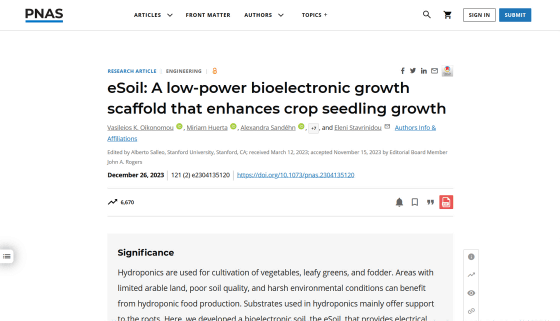It turns out that applying electrical stimulation to plant roots promotes growth.

Similar to humans and other animals, electrical signals flow through plants, and electrical activity causes
eSoil: A low-power bioelectronic growth scaffold that enhances crop seedling growth | PNAS
https://www.pnas.org/doi/10.1073/pnas.2304135120

Electronic “soil” enhances crop growth - Linköping University
https://liu.se/en/news-item/elektronisk-jord-okar-tillvaxten-hos-grodor
Zapping Baby Plant Roots With Electricity Boosts Growth by 50% : ScienceAlert
https://www.sciencealert.com/zapping-baby-plant-roots-with-electricity-boosts-growth-by-50
As the world's population increases, food problems are becoming more serious, and the United Nations Food and Agriculture Organization (FAO) estimates that 783 million people will face hunger in 2022, an increase of 122 million people compared to 2019. It is reported that the number of people has also increased. As a solution to the intensifying food problem, methods of efficiently increasing the yield of grains, vegetables, etc. are attracting attention.
Hydroponic cultivation uses only scaffolding to fix water, nutrients, and roots without using soil, so it can grow plants with less water and fertilizer than other farming methods, and can grow vegetables even in areas where the soil is not suitable for plants. You can harvest etc. In addition, compared to outdoor cultivation, the required planting area is smaller, and cultivation equipment can be stacked vertically, making it possible to create a next-generation 'vertical farm' inside a building or warehouse.
Eleni Stavrinidou, associate professor at Linköping University's Institute of Organic Electronics, said: 'With the world's population growing and climate change occurring, it is clear that existing farming methods alone will not be able to meet the world's food needs. 'Obviously, but with hydroponics we can grow food in a well-managed environment, even in cities.'
In order to increase yields in hydroponic cultivation, the research team led by Mr. Stavrinidou developed a ``low-power hydroponic cultivation system that applies a constant voltage to the roots of barley seedlings''. In this system, barley was secured to a conductive scaffold called 'eSoil' and subjected to a low voltage for five days.

eSoil is a mixture of

The research team placed barley plants in eSoil after 5 days of germination and grew them for 5 days with low voltage applied, then for another 5 days with electrical stimulation turned off.
The results showed that the electrically stimulated barley was 50% heavier on average in dry weight and grew 30% longer than the control barley. The mechanism by which electrical stimulation promotes barley growth is unclear, but experiments suggest that energized barley converts nitrate to nitrogen-containing biomass more efficiently.
'This method allows seedlings to grow faster with fewer resources, but it is still unclear how it actually works and what biological mechanisms are involved,' Stavrinidou said. 'What we found is that seedlings process nitrogen more efficiently, but we don't know how electrical stimulation affects this process.'
It is also worth noting that the difference in barley growth did not occur during electrical stimulation, but rather during the 5-day period from when the electrodes were switched off until the end of cultivation. Masu. This suggests that even electrical stimulation shorter than 5 days can have a lasting effect on plant growth.
'In conclusion, we developed a bioelectronic growth scaffold, eSoil, that improved the growth of hydroponic barley seedlings by an average of 50% after electrical stimulation,' the researchers wrote in their paper. ``However, as our study focused on seedlings, further research is needed to know whether growth promotion through stimulation of early growth stages affects the entire plant growth cycle.'' ” he said.

Related Posts:







